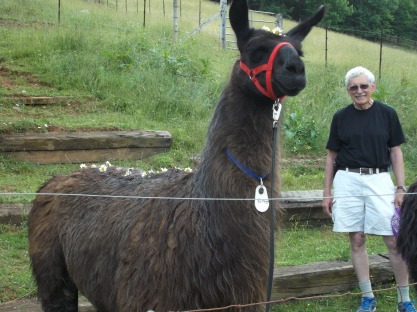Everybody is filled with stories, and just about every has at least one or two good stories they enjoy telling, however there are a few folks who I like to call natural tellers. They might tell tales as they sit on the front porch or at the kitchen table, or they spin them as they do surgery or sell products. They love to tell and they seem to have an endless supply spellbinding stories, and most natural tellers seem to be very successful in one or more aspects of their lives.
Qualities of a natural teller:
• They have interesting/exciting lives and/or they come from interesting and exciting families.
• They use their stories as a way to communicate
• They willingly share their stories and allow others to pass them on.
• They are good listeners.
Now let’s meet a natural teller: George W. Appenzeller
George runs a llama farm in Blue Ridge Mountains of North Carolina. He’s in his seventies, has a head of pure white hair, and a smile that conveys a bushel load of encouragement. He takes small groups of kids on treks through the mountains and allows them to discover their inner strength. Challenge Adventures is a non-profit that focuses on kids who have faced trauma, abuse, poverty, and other challenges. He also does a few programs with scouts and other youth groups. I spent a week at the llama farm and in the mountains with a group of girls from Camp CADI, an arts and adventure camp for survivors of sexual abuse.
Caring for llamas and leading wilderness adventures seems to fit the first quality of natural tellers–interesting lives, but for George that’s just the tip of his story iceberg. He served in the military, worked in theater, got a degree in Russian history, then a master’s in social work. He and his wife have traveled the world doing environmental studies and they have a business evaluating the effectiveness of programs. Plus he has a llama farm. OK, he’s interesting.
On the second day of our llama walk in the mountains we all went on a 6 mile hike to a waterfall. After an hour or so, we took a break near a stream. George began to talk about the llamas, plants, and terrain for a couple minutes then rolled right into a story. Once he took a group of scouts with their parents hiking and they set up camp just where we were sitting. George and the other guides suggested moving the tents to higher ground, away from the river. The parents preferred the lower, flatter ground. That night it rained; George and the guides stayed dry, the scouts and their dads got soaked. George told the story with a sparkle in his eye and in a simple matter of fact style. It got a laugh and successfully demonstrated the wisdom of listening to guides (and the people in our lives that have experience and knowledge). No lecture, just a simple story. George uses his stories to communicate.
I got into North Carolina ahead of my group, so I had time to meet and chat with his staff. Natural storytellers are usually very generous with their stories and will tell for hours with no end in sight. I asked permission to tell a couple of George’s stories and he said yes right away. He’s willing to share his stories and pass them on.
Now most of the mountain paths are narrow and we each led a llama, so we walked single file. Mountain paths are rocky and I spent the majority of my time looking at my llama or the uneven path, but every now and again I’d look up and see George walking next to one of the girls, just listening. He didn’t rush people, he listened at their pace. Yep, George is a good listener.
People remember natural tellers because they tend to nourish a place in our consciousness that excites both our hearts and our minds. If you find a natural teller, clear some time in your calendar so you can just sit together and talk.
If you are a natural teller (or you know one), please take note. Natural Tellers tend to tell and not save their stories. A story coach, unlike a writing coach, will honor the spoken word process but still find a way to save these precious stories. Often told stories already have their form, but they are a bit like Jello, they wiggle a bit when you want to save them. Creating a structured time and setting goals is the best way to save stories so they can be passed on.
If you’d like to learn more about George and Challege Adventures check out his website at http://www.challengeadventures.com. I’ll be writing more about Camp CADI in my next blog. Check out this amazing program http://www.safegirlsstronggirls.org/ Both groups do amazing work and rely on donations so if you can, please donate.
Learn more about story coaching or schedule a session with me at Rivka@SimplyExtraordinaryTales.com.
Mention this blog and receive $50 off a 4 session package.
